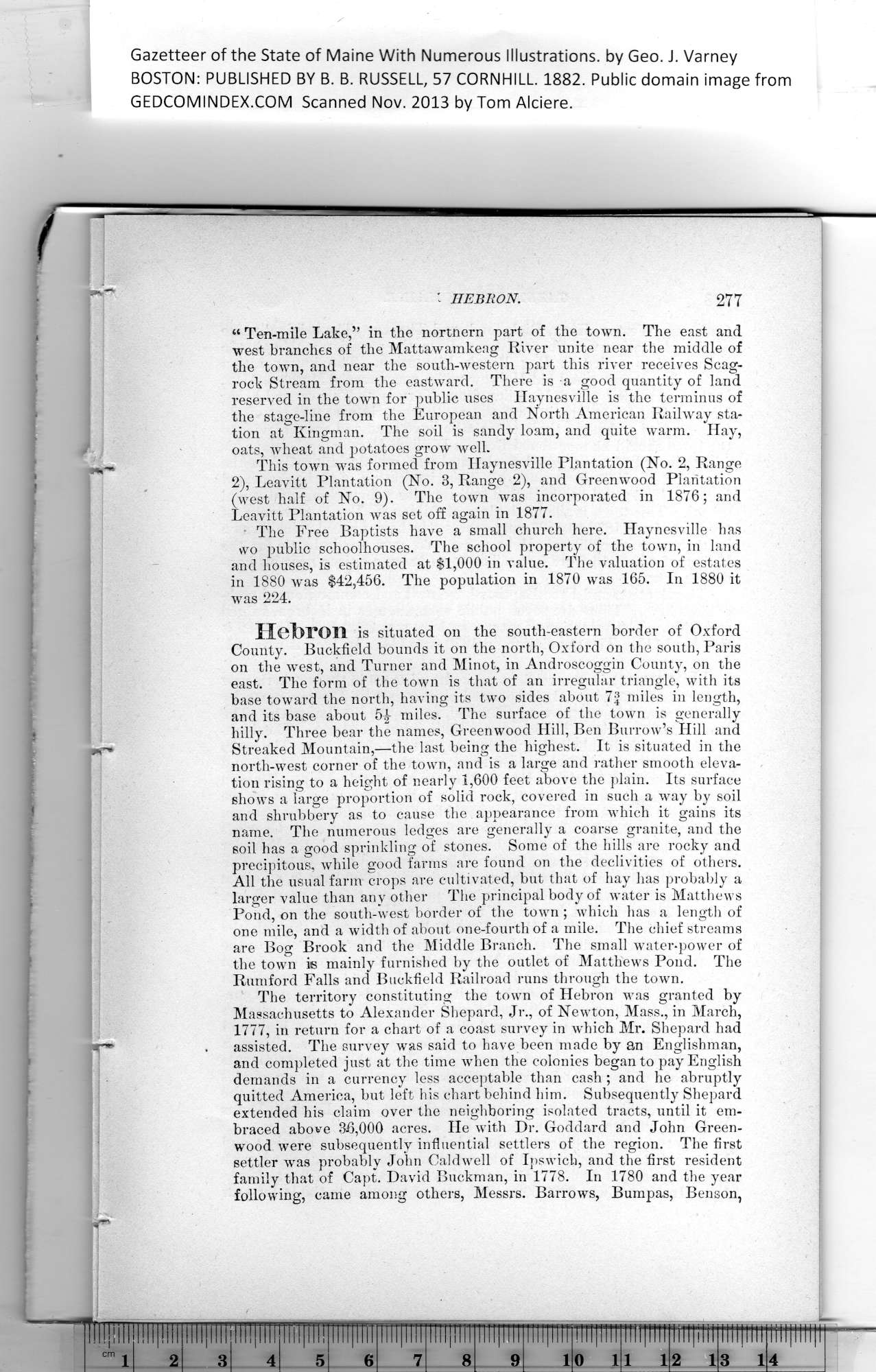|
Gazetteer of the State of Maine With Numerous Illustrations, by Geo. J. Varney
BOSTON: PUBLISHED BY B. B. RUSSELL, 57 CORNHILL. 1882. Public domain image from
HEBRON. 277
“ Ten-mile Lake,” in the nortnern part of the town. The east and
west branches of the Mattawamkeag River unite near the middle of
the town, and near the south-western part this river receives Scag-
rock Stream from the eastward. There is a good quantity of land
reserved in the town for public uses Haynesville is the terminus of
the stage-line from the European and North American Railway sta-
tion at Kingman. The soil is sandy loam, and quite warm. Hay,
oats, wheat and potatoes grow well.
This town was formed from Haynesville Plantation (No. 2, Range
2), Leavitt Plantation (No. 3, Range 2), and Greenwood Plantation
(west half of No. 9). The town was incorporated in 1876; and
Leavitt Plantation was set off again in 1877.
The Free Baptists have a small church here. Haynesville has
wo public schoolhouses. The school property of the town, in land
and bouses, is estimated at $1,000 in value. The valuation of estates
in 1880 wrns $42,456. The population in 1870 was 165. In 1880 it
was 224.
Hebron is situated on the south-eastern border of Oxford
County. Buckfield bounds it on the north, Oxford on the south, Paris
on the west, and Turner and Minot, in Androscoggin County, on the
east. The form of the town is that of an irregular triangle, with its
base toward the north, having its two sides about 7| miles in length,
and its base about 5£ miles. The surface of the town is generally
hilly. Three bear the names, Greenwood Hill, Ben Burrow’s Hill and
Streaked Mountain,—the last being the highest. It is situated in the
north-west corner of the town, and is a large and rather smooth eleva-
tion rising to a height of nearly 1,600 feet above the plain. Its surface
shows a large proportion of solid rock, covered in such a way by soil
and shrubbery* as to cause the appearance from which it gains its
name. The numerous ledges are generally a coarse granite, and the
soil has a good sprinkling of stones. Some of the hills are rocky and
precipitous, while good farms are found on the declivities of others.
All the usual farm crops are cultivated, but that of hay has probably a
larger value than any other The principal body of water is Matthews
Pond, on the south-west border of the town ; which has a length of
one mile, and a width of about one-fourth of a mile. The chief streams
are Bog Brook and the Middle Branch. The small water-power of
the town is mainly furnished by the outlet of Matthews Pond. The
Rnmford Falls and Buckfield Railroad runs through the town.
The territory constituting the town of Hebron was granted by
Massachusetts to Alexander Shepard, Jr., of Newton, Mass., in March,
1777, in return for a chart of a coast survey in which Mr. Shepard had
assisted. The survey was said to have been made by an Englishman,
and completed just at the time when the colonies began to pay English
demands in a currency less acceptable than cash ; and he abruptly
quitted America, hut left his chart behind him. Subsequently Shepard
extended his claim over the neighboring isolated tracts, until it em-
braced above 36,000 acres. He with Dr. Goddard and John Green-
wood were subsequently influential settlers of the region. The first
settler was probably John Caldwell of Ipswich, and the first resident
family that of Capt. David Buckman, in 1778. In 1780 and the year
following, came among others, Messrs. Barrows, Bumpas, Benson,
PREVIOUS PAGE ... NEXT PAGE
This page was written in HTML using a program written in Python 3.2
|
